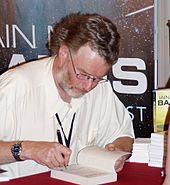 There aren’t too many first novels as brilliant and terrifying as Iain Banks’ THE WASP FACTORY. First published in 1984, this outrageous account of prophecy, murder, maggots, rabbit torture, dog burning and gender confusion is in my view the premiere horror novel of the decade, and one of the finest—and certainly most unique—accounts of first person psychosis ever written. Many commentators claim Iain Banks never quite matched its eccentric power in any of his 26 subsequent novels, and I’ll have to agree—although I do believe Banks did come close on several occasions, with the humor, imagination and brilliant writing of THE WASP FACTORY suffusing the entirety of his output.
There aren’t too many first novels as brilliant and terrifying as Iain Banks’ THE WASP FACTORY. First published in 1984, this outrageous account of prophecy, murder, maggots, rabbit torture, dog burning and gender confusion is in my view the premiere horror novel of the decade, and one of the finest—and certainly most unique—accounts of first person psychosis ever written. Many commentators claim Iain Banks never quite matched its eccentric power in any of his 26 subsequent novels, and I’ll have to agree—although I do believe Banks did come close on several occasions, with the humor, imagination and brilliant writing of THE WASP FACTORY suffusing the entirety of his output.
In the UK Banks was a larger-than-life figure. His fame was spurred by the enormous controversy that greeted the publication of THE WASP FACTORY, as well as his several-degrees-to-the-left-of-Karl Marx political views and hedonistic drug-and-alcohol fuelled lifestyle (which he apparently gave up in his later years). Banks also received several awards in his day, and was the subject of at least two high profile British TV profiles.
 Here in the US, of course, Banks is little known and (until recently) his books barely published. Indeed, being a Banks fan on these shores was a constant source of frustration during the late eighties and early nineties. Back in those pre-Amazon days most of Banks’ publications could only be had through mail order outfits that imported books from the UK, which entailed wildly inflated prices and frustratingly long shipping times. Still, the books were usually always worth the cost it took to track them down.
Here in the US, of course, Banks is little known and (until recently) his books barely published. Indeed, being a Banks fan on these shores was a constant source of frustration during the late eighties and early nineties. Back in those pre-Amazon days most of Banks’ publications could only be had through mail order outfits that imported books from the UK, which entailed wildly inflated prices and frustratingly long shipping times. Still, the books were usually always worth the cost it took to track them down.
As you longtime Banks fans well know, his publications were split into two distinct factions: those that were science fiction themed, credited to “Iain M. Banks,” and those that weren’t, which appeared without the M. I’ll admit I’ve largely ignored the Iain M. Banks novels, having only read the first of them, 1987’s CONSIDER PHLEBAS. I found that novel exceedingly well written, certainly, but also quite dull. Space opera simply isn’t my thing, meaning I skipped subsequent Banks sci fi efforts like THE PLAYER OF GAMES, USE OF WEAPONS, FEERSUM INDJINN and TRANSITION.
As for the rest of Banks’ output, I’ve kept up. I particularly enjoyed 1985’s WALKING ON GLASS, which mixes horror and sci fi into a wholly unique whole. THE BRIDGE is a laudable (if overlong) hallucinatory fantasy and ESPEDAIR STREET a brutally funny rock biopic that amply demonstrates Banks’ flair for the grotesque (the elaborate killing of one of its protagonists is as magnificently repellent as anything in THE WASP FACTORY). The same is true of the nostalgic yet hard-edged semi-autobiographical family epic THE CROW ROAD (probably my favorite Iain Banks novel after THE WASP FACTORY), the highly eccentric political thriller CANAL DREAMS and the disturbing apocalyptic saga SONG OF STONE, which ranks with classics of the form like ON THE BEACH and VALHALLA.
WALKING ON GLASS, which mixes horror and sci fi into a wholly unique whole. THE BRIDGE is a laudable (if overlong) hallucinatory fantasy and ESPEDAIR STREET a brutally funny rock biopic that amply demonstrates Banks’ flair for the grotesque (the elaborate killing of one of its protagonists is as magnificently repellent as anything in THE WASP FACTORY). The same is true of the nostalgic yet hard-edged semi-autobiographical family epic THE CROW ROAD (probably my favorite Iain Banks novel after THE WASP FACTORY), the highly eccentric political thriller CANAL DREAMS and the disturbing apocalyptic saga SONG OF STONE, which ranks with classics of the form like ON THE BEACH and VALHALLA.
Even lesser efforts like the violent whodunit COMPLICITY (whose riveting first half gives way to a rather dreary and uninspiring second one), the bloated religious cult saga WHIT and the rambling 9/11 meditation DEAD AIR still amply showcase Iain Banks’ not-inconsiderable range and imagination.
 You can add prophetic to those superlatives, based on Banks’ final novel THE QUARRY. It concerns a man dying of cancer, just as Iain Banks (unknowingly) was at the time of its writing. I have yet to read it, although I have read the mostly ecstatic reviews of the book, as well as Banks’ own considerably less glowing assessment: “If I’d known it was going to be my last book, I’d have been quite disappointed that I’m going out with a relatively minor piece…” For the record, THE QUARRY was published just 11 days after Banks’ untimely death on June 9, 2013. Here’s hoping it does indeed prove to be a worthy summation of the career of this one-of-a-kind writer.
You can add prophetic to those superlatives, based on Banks’ final novel THE QUARRY. It concerns a man dying of cancer, just as Iain Banks (unknowingly) was at the time of its writing. I have yet to read it, although I have read the mostly ecstatic reviews of the book, as well as Banks’ own considerably less glowing assessment: “If I’d known it was going to be my last book, I’d have been quite disappointed that I’m going out with a relatively minor piece…” For the record, THE QUARRY was published just 11 days after Banks’ untimely death on June 9, 2013. Here’s hoping it does indeed prove to be a worthy summation of the career of this one-of-a-kind writer.
R.I.P. Iain Banks/Iain M. Banks
